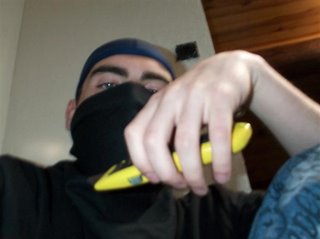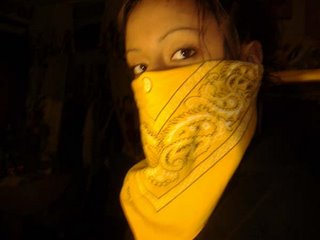Anonymous and Easier to Murder, Easier to Be Killed

“I now feel that any environmental, societal conditions that contribute to making some members of society feel that they are anonymous, that no one knows who they are, that no one recognizes their individuality, and thus their humanity, makes them potential assassins and vandals, a danger to my person and my property, and yours.”
–Phillip Zimbardo.
Doctor Phillip G. Zimbardo is known for his experiments in 1971 where he designed a “fake” prison situation using volunteers to demonstrate how anonymity, diffusion of responsibility, and group interactions in stressful situations could lead to violent and dehumanizing outcomes when left unchecked. (Though my definition is overly simple you may read a more definitive understanding of Zimbardo’s work on his website).
There are several key elements in Zimbardo’s groundbreaking work that I would like to relate to gang and other deviant groups.
Scott Fraser as sited by Zimbardo, did an experiment that demonstrates how being “anonymous” or perceiving oneself as having an anonymous identity contributes to the tendency for anonymity to make aggression more likely:
Children invited to a Halloween party were asked to play several games. In the first game they did not wear costumes to participate. In the next game costumes were worn and in the final phase of the experiment costumes were once again removed. Zimbardo notes:
“Aggression increased significantly as soon as the costumes were worn, more than doubling from the initial base level average. But when the costumes were removed, aggression dropped back well below the initial level base rate. Equally interesting was the second result, that aggression had negative instrumental consequences on winning tokens, it cost money to be aggressive, but that did not matter when the children were costumed and anonymous.”
How does this relate to gangs and other deviant groups? The essence of belonging to a gang means surrender of one’s personal identity. You are not so much “you” anymore but rather you represent as a “Crip” or Blood or whatever gang you are associated with. Being in a gang also relates to the young person’s feelings of not being an important person, sometimes in the home, sometimes in society itself. It is by becoming a member of the gang or deviant group that your identity is established. And that identity is a group one rather than an individual one. Often gang members are not even called by their own birth names but have a street nickname, even more so removing personal identity. Thereby, according to this and other experiments such as Zimbardo’s prison experiment, makes it easier for the individual to be aggressive.
On the other side of that token, as we look at Dave Grossman’s work (On Killing, 1995), it becomes easier for others to kill or be aggressive towards the individual who is not recognized as an individual but rather as an object. In the case of gangs, as a Crip etc…rather than as “Joe Smith”.
Zimbardo goes on to reference other research such as society’s that change their warrior’s appearance (wearing of masks, war paint, etc…) as being notably more aggressive in combat and often more successful in combat. How many gang members, terrorists, and other deviant combative groups in today’s society disguise their appearance in the warrior “masks” of blue or red bandannas and similar items?
In this blog we have also looked at how “Diffusion of Responsibility” plays a role in group violence by reducing the individual’s feelings of accountability and thereby remorse because feelings of guilt are diffused across the group rather than resting solely on the individual. “It is the group, i.e. the Crips that killed that guy, not me.”
Dehumanization and demonization of the “target” of rival groups contributes to this propensity of aggression towards the “target” and thus makes it easier to maim or kill.
What follows is, I think, the crux of Zimbardo’s observations. After each Zimbardo notation I will post my comments as the points relate to gang / deviant group assimilation.
Ten Ingredients in the Situationist’s Recipe for Behavioral Transformations:
Presenting an acceptable justification, or rationale, for engaging in the undesirable action. (Often with gangs and dev-groups, the rationale for violence is the protection of perceived threats to their groups’ well being, territorial control, or impending “destruction” of their ideological / religious or political beliefs. These elements of rationale are generally contrived or exaggerated to increase group cohesion. Fear makes groups more readily work together, even if that fear is one manufactured by the leaders.)
Arranging some form of contractual obligation, verbal or written, to enact the behavior. (With gangs and dev-groups the “obligation” is first established and continually reinforced in the indoctrination. Commitment to one’s group and therefore the “cause” is key to maintaining an obligation to do what is necessary to remain a part of the group).
Giving participants meaningful roles to play that carry with them previously learned positive values and response scripts. (Gangs and most dev-groups develop a chain of command in which members work their way up and thus are assigned various responsibilities.)
Presenting basic rules to be followed, that seem to make sense prior to their actual use, but then can be arbitrarily used to justify mindless compliance. (Gangs and dev-groups almost always have a set of laws or binding rules that are essential to continued gang involvement. These rules such as are found in the Gangster Disciple’s for example, can include the 6 laws found illustrated on the 6 pointed star, which are: Love, Life, Loyalty, Wisdom, Understanding, and Knowledge. While this “code of honor” seems to make sense and superficially appear to be positive ideals they are in turn used to make the group feel more justified in whatever response is needed to protect the integrity of the group. Other less ideological rules also apply such as “protecting one’s colors” or territory from invaders, and being their for your “brothers”, are used to initiate the desires of the leadership, which in reality are almost always a part of maintaining control of the group and his financial interests.)
Altering the semantics of the act and action, from hurting victims to helping others by punishing them. (Gangs / dev-groups protect their territory, membership, ideological or religious beliefs and therefore their own group identity by acts of violence. Killing a rival gang member or “infidel” isn’t really hurting someone so much as it is “defending” the group. The act of violence becomes a necessity, one that was initiated by the opponent even if only perceived that forces the participant to act violently. “He brought it on himself” or he / it was a threat that had to be neutralized. This is just as reminiscent of gangs as it is of groups like Al Qaeda and their perceived need to serve God by ridding the world of the “evil” western influence. They are in essence “cleansing” the world from the unrighteous and in doing so are serving a holy God. With religious deviant groups like Al Qaeda, even the loss of innocent Muslims killed in attacks on infidels means that they will go to heaven and are not truly collateral damage.)
Creating opportunities for diffusion of responsibility for negative outcomes; others will be responsible, or it won’t be evident that the actor will be held liable. (As noted earlier, it is not “Joe Smith” who killed that Vice Lord, it was the Gangster Disciple Nation.)
Starting the path toward the ultimate evil act with a small, insignificant first step. (Initiation into the gang or dev-group itself, selling drugs to make money “to survive”, or showing personal commitment to honor the will of God.)
Increasing the level of aggression in gradual steps, that do not seem like noticeable differences. (Verbal aggression towards rival members, painting disrespectful graffiti aimed at rival gangs, showing disrespect towards rivals with hand signs. All of which almost always lead one member to act violently towards a rival as confrontation becomes more heated. The same is true with ideological, political, and religious fanatical groups who may begin by aggressive protests, acts of vandalism, and verbally aggressive statements about the “enemy.”)
Gradually changing the nature of the Influence Authority from “Just” to “Unjust,” from reasonable and rational to unreasonable and irrational. (Gang leaders, political, religious representatives, or ideological cult leaders may offer hope, brotherhood, or family for disenfranchised youth. They may appear as loving father figures but over time will send the ones they claim to “love” into violent confrontations to defend drug territory, holy relics, or the like which in reality translates to the leader’s pocketbook and position of power. These same leaders may enforce obedience with threats of violence over time and exposure to the gang / dev-group lifestyle.)
Making “exit costs” high, and the process of exiting difficult by not permitting usual forms of verbal dissent to qualify as behavioral disobedience. (Many gangs claim that in order to “get out” you must “die out” or take a severe beating. Threats to harm the dissenter’s family may also be common. The same is true with most dev-groups. Dissenters who may openly and verbally protest to anything the group wants face the threat of violence.)
When a young person, or any individual feels alone, disenfranchised or otherwise rejected by conventional society his propensity to act out with violence may increase. This fear driven emotion tends to promote the anger response thereby making violence more likely.
When such an individual is accepted into some sort of group after being rejected (or feeling as though he has been rejected) and that group is one in which violence is a strong element his propensity to act violently may increase exponentially. The more radicalized the group and the more the group plays to the individuals feelings of rejection the more likely he will be assimilated into the group’s negative and dangerous membership.
Even in small groups, such as two to three individuals this propensity towards violence can dramatically increase. The two students who murdered numerous classmates at Columbine did so not because they were
 frustrated with their economic status (they drove to the school with a BMW full of guns) but because they felt ostracized. The key is they “felt” ostracized and anonymous not necessarily that they were.
frustrated with their economic status (they drove to the school with a BMW full of guns) but because they felt ostracized. The key is they “felt” ostracized and anonymous not necessarily that they were.The same is true with gang and deviant group members. The more anonymous they feel the more likely they will find identity with a deviant group and therefore despite losing more of their individuality may further descend into the cycle of violence.
Any number of situations, mental conditions, or people can make us feel anonymous. But we can also view the world as being an anonymous thing. We are more aggressive driving down the road, (road rage), because people “out there” beyond our windshields are less real, are part of a machine (the car) and therefore less human. We do not see them as people with loves, fond memories, troubles, or as someone’s son, daughter, or child. They become an “it.” Their anonymity makes it easier to become angry with them. At the same time, if we feel we are not part of something, not part of what is accepted, we may feel anonymous.
Being anonymous makes it easier to kill. Being in a group that views the world as not a collection of individuals but as a faceless (anonymous) entity threatening to destroy that group makes the anonymous world easier to murder.


